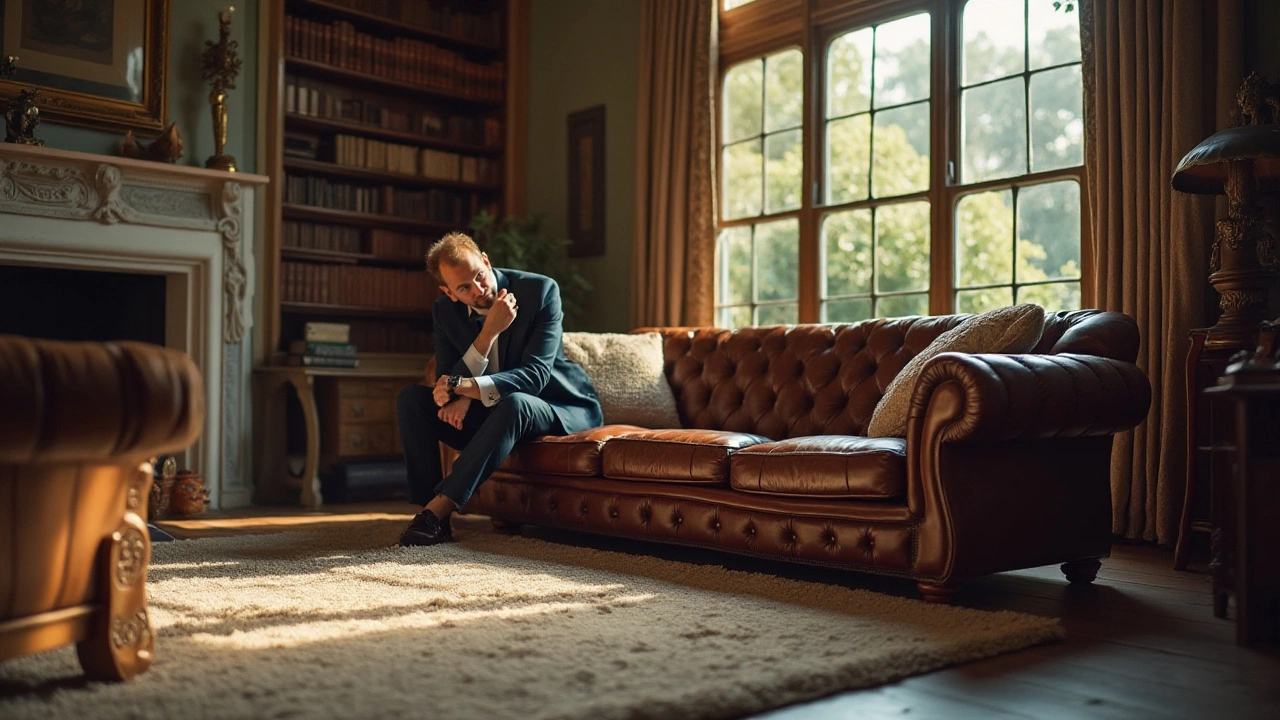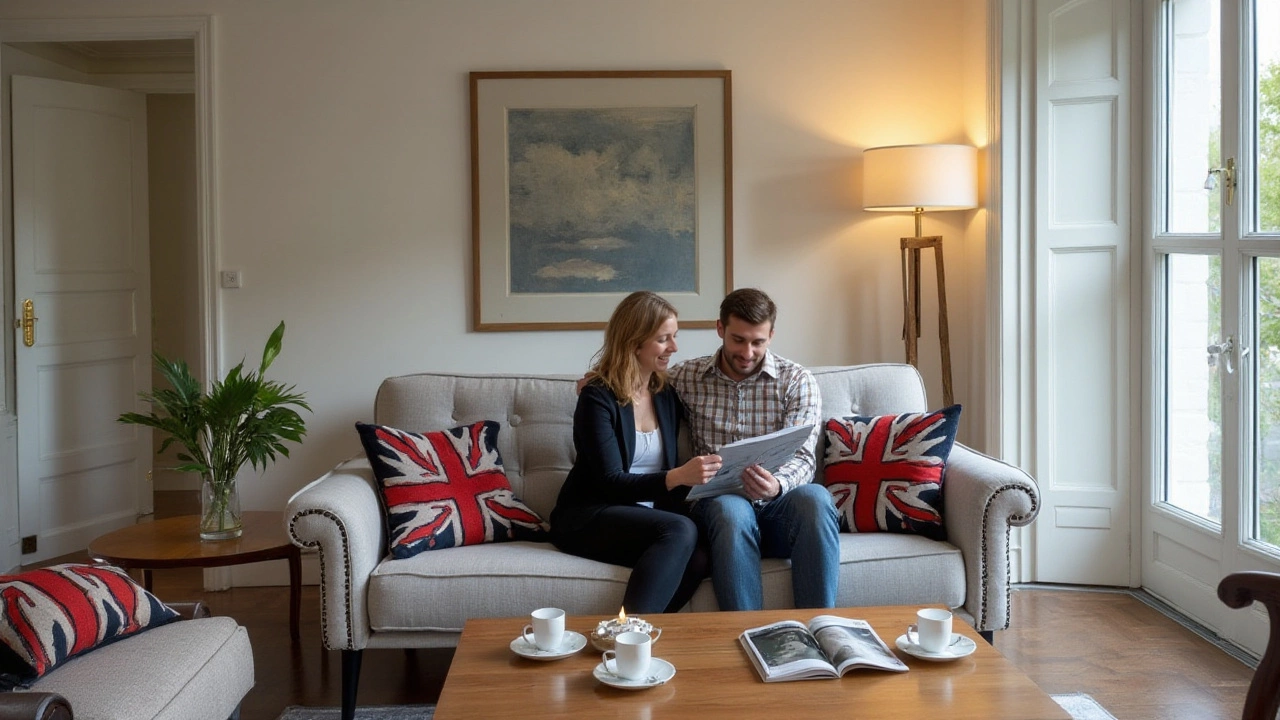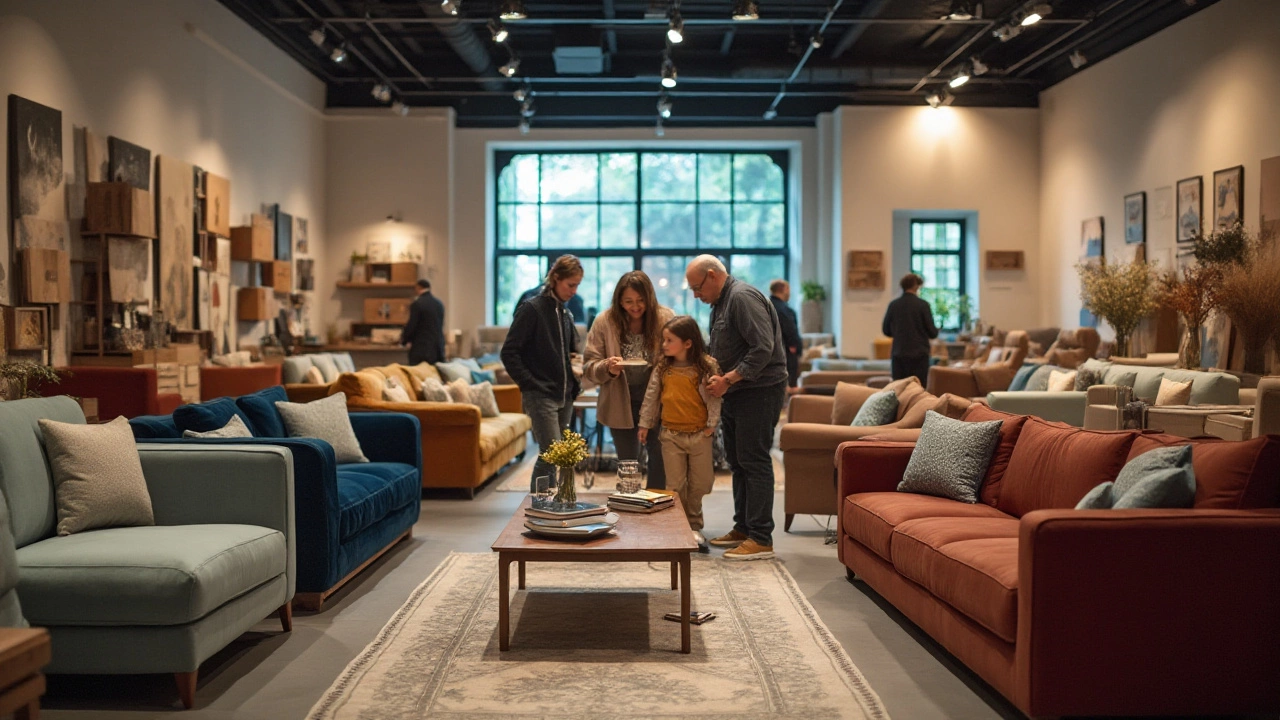How Much Should You Spend on a High-Quality Sofa?
 Dec, 15 2024
Dec, 15 2024
When it comes to buying a sofa, the range of prices can be astonishing. From budget-friendly options to extravagant designer pieces, knowing what makes a sofa a worthwhile investment is key. A good sofa goes beyond aesthetics, influencing comfort and longevity in your home environment.
Several factors determine the cost of a sofa, and deciphering these can be tricky. It’s important to know how materials, craftsmanship, brand reputation, and even market trends play roles in pricing. The right balance between these elements can lead you to the sofa that fits both your financial and lifestyle needs.
- Understanding Sofa Pricing
- Materials and Their Impact on Cost
- Construction and Craftsmanship
- Brand Influence and Market Trends
- Budgeting for Different Quality Levels
Understanding Sofa Pricing
Sofa pricing is a complex subject that depends on a multitude of factors. At its core, the pricing of a sofa is determined by the materials, construction, brand, and the current market demand. Each of these components plays a critical role in defining how much you’ll pay, and understanding them can help prevent any surprise on your invoice. When you look at a price tag, it's reflecting much more than the physical components; it tells a story of craftsmanship, artistry, and market dynamics.
Materials are perhaps the most tangible aspect affecting sofa costs. The fabric or leather used can vary greatly in price. For instance, a high-end aniline leather sofa could cost several thousand dollars, while a fabric sofa might offer a wider range of price points. An important consideration is also the frame, often built from hardwood or engineered materials. Hardwood frames, known for durability, typically raise the price. It’s important to align your choice with how often you expect to use the sofa and how long you plan to own it.
Construction techniques are closely tied to the level of craftsmanship involved. Handcrafted pieces with intricate details or custom features are naturally more expensive than mass-produced alternatives. The type of joinery, cushioning, and even the stitching details can significantly impact the cost. As a general rule, the more labor-intensive processes involved, the higher the price. A well-constructed sofa, though pricier at first, can prove to be a better investment over time through enhanced durability and comfort.
As furniture designer John May declared, "A sofa is more than just a place to sit — it represents a confluence of artistry and engineering."
Brands also influence sofa pricing considerably. Established brands might charge premium prices due to their reputation and the perceived value of their products. These brand markups often go hand-in-hand with guarantees of quality and support. However, don’t disregard smaller, lesser-known brands, which may offer excellent quality at competitive prices as they are building their market presence. A bit of research could unveil surprising gems in terms of value and uniqueness.
Finally, market trends and consumer demand shape the price landscape. Certain styles or colors may become trendy, driving prices up temporarily. Economic conditions, such as inflation or the cost of raw materials, also impact sofa prices. Understanding the timing of your purchase can help you navigate these fluctuations effectively. Staying informed about these elements can empower you to make a well-timed purchase, potentially saving money while ensuring satisfaction with your furniture buying decision.
Materials and Their Impact on Cost
The type of material used in crafting a sofa significantly influences its price and quality. Understanding the differences between materials can help you make an informed decision tailored to your needs. Let's delve into the diverse world of upholstery, where choices range from budget-friendly polyester to luxurious aniline leather.
Starting with fabric sofas, polyester is often seen as an entry-level option due to its affordability and durability, making it ideal for families or pet owners where spills and accidents are likely. On the other hand, velvet has made a comeback, adding an element of luxury and softness to any living space. While pricier, the tactile beauty and variety of color it offers make it a popular choice among trendsetters. Linen and cotton, meanwhile, offer breathable comfort and a casual vibe, though they might not resist wear as robustly as their synthetic counterparts.
In the realm of leather, different types bring varied price tags and maintenance requirements. Top-grain leather, made from the top cut of the hide, balances a smooth texture with endurance, making it a favorite for quality furniture buying. Aniline leather, untreated beyond the dye process, showcases a natural aesthetic that ages beautifully, though it comes with a hefty price due to its vulnerability to stains. Bonded leather, while cost-effective, serves as a less durable alternative, crafted from leather scraps and polyurethane.
"Investing in quality materials often results in a higher initial cost, but it can save money and hassle in the long run," suggests interior designer Emily Maxwell.
Apart from the fabric, the interior framework also plays a crucial part. Hardwood frames, such as kiln-dried oak or beech, contribute to a high-end product due to their remarkable longevity and resistant properties. Conversely, softwoods or engineered woods, like plywood, are typically used in more affordable models but might not offer the same durability.
Sofa cost is not just about aesthetics; it's about matching your anticipated use with the right materials. If you're seeking longevity and have budget flexibility, opting for superior materials pays off with time. Whether your focus is on aesthetics, comfort, or practicality, knowing these material impacts facilitates smarter investments and a happier home experience.

Construction and Craftsmanship
The intricate blend of construction and craftsmanship plays a pivotal role in defining a sofa's quality and cost. A well-constructed sofa begins with its frame, typically crafted from high-density hardwoods such as oak, maple, or birch. These woods are chosen for their durability and resistance to warping. A hallmark of fine artisan work is the use of kiln-dried wood that prevents the frame from twisting over time, ensuring your sofa maintains its shape for decades.
Joinery techniques add another layer to a sofa's resilience. The best sofas will have frames joined by corner blocks, dowels, and even double-dowelled joints, rather than the corner-cutting methods of staples or nails. Such meticulous attention to detail reflects in both durability and price, making these sofas a lifelong investment. For added stability, some manufacturers also employ reinforced steel brackets in strategic spots, boosting the structural integrity while keeping a sleek design.
The suspension system is another key consideration. High-quality sofas often feature sinuous springs or hand-tied, eight-way springs, which deliver firm yet responsive support. Experts frequently quote,
"A well-made sofa should support without sagging, allowing the piece to cradle you in comfort,"illustrating the priority given to spring systems. Cheap sofas might cut corners with simple webbing or lesser spring configurations, leading to a shorter lifespan and a less comfortable experience.
Cushion filling is equally crucial in determining the feel and longevity of your sofas. Feather and down cushions offer unrivaled comfort but can require regular maintenance to keep their shape. High-resilience foam often strikes a balance between plushness and easy upkeep, maintaining its form over the years. Many luxury brands blend these materials to combine the buoyant support of foam with the soft touch of feathers, providing both comfort and durability at a premium price.
An emerging trend in sofa manufacture is a commitment to sustainable practices. More brands now prioritize eco-friendly materials and processes without compromising on aesthetics or performance. Recycled fabrics and responsibly sourced woods are gaining popularity, addressing consumers' growing environmental awareness without sacrificing quality or style. Such conscientious craftsmanship justifies a higher cost and resonates with eco-conscious buyers.
Amidst these various facets of craftsmanship, understanding the interplay between these elements is crucial. The next time you consider buying a sofa, appreciating these behind-the-scenes details can aid you in evaluating why some pieces carry a bigger price tag. High-quality sofas reflect an investment in time-honored techniques that ensure you aren't just buying furniture, but a piece of art that will be a central part of your home for years to come. Always remember, in the realm of furniture buying, you often get what you pay for, making informed decisions based on these factors incredibly important.
Brand Influence and Market Trends
In the realm of furniture shopping, the influence of a brand can greatly impact the cost of a sofa. Brands build their reputation on quality, design, and longevity, and these attributes are often reflected in their pricing. Well-known luxury brands tend to charge a premium, and for many, this premium represents a promise of superior quality, better materials, and high-end craftsmanship. A brand like Pottery Barn or Crate & Barrel, for instance, has established a name synonymous with reliability and timeless style, and their sofas often come with price tags that signal these attributes. It's not just the sofa itself you're buying, it's the assurance of what the brand stands for.
Sofa trends also play a significant role in determining prices. Just as in fashion, styles change, and what was trendy last year might not hold the same appeal today. Mid-century modern styles, for example, have seen surges in popularity, translating to increased demand and, consequently, higher prices. Brands that are adept at capturing the zeitgeist of home decor tend to leverage current trends to justify a higher price point. This tactic works well with customers who are keen on staying updated with the latest styles.
Let's not ignore the strategic marketing and savvy positioning some brands employ. Limited edition releases and collaborations with famed designers can dramatically spike prices. These exclusive pieces often become coveted items, driving up demand and giving brands the liberty to set higher price points. A statement piece from a famous designer can be more than just a sofa; it's a conversation starter, a testament to one's taste in finer things. According to an article by The New York Times,
"The emotional and functional bond people find in designer furniture can transcend its utility, turning into an investment both financially and sentimentally."
Market trends reveal interesting dynamics about consumer behavior. For example, there has been a noticeable shift towards sustainability in the market. With consumers becoming more environmentally conscious, brands that offer eco-friendly or sustainably sourced products can justify higher prices. People are more willing to invest in furniture that aligns with their personal values, and brands capitalize on this by incorporating sustainable practices into their branding and manufacturing processes.
The world of furniture is ever-changing, and keeping an eye on these trends helps consumers understand the market dynamics that drive sofa prices. Shifts in community and global economics such as inflation, changes in material costs due to geopolitical events, or even a shift towards remote work affecting home design, can all impact pricing structures. By understanding these factors, one can make a more informed decision when investing in a quality piece of furniture.

Budgeting for Different Quality Levels
When diving into the world of sofas, understanding the financial landscape can ease your decision-making process. From entry-level to luxury, sofas cater to varied budgets. A key factor in setting your budget is recognizing what stage of life you are in and how your living situation might evolve. Many young professionals, for instance, opt for affordable options that can withstand a good amount of wear and tear during the early years of their independent living. These budget-friendly models typically feature synthetic fabrics and particleboard frames that do the job but don’t offer the longevity or aesthetic appeal of higher-priced models.
Mid-range sofas are a sweet spot for many households seeking a balance of cost and durability. This category often includes pieces with hardwood frames and higher-end fabric options like cotton or linen blends. These sofas serve as a staple in homes desiring both durability and style without breaking the bank. An interesting data point from the American Home Furnishings Alliance noted that mid-range sofas account for about 50% of the market purchases, embodying the dual appeal of accessible quality and reasonable pricing.
"Investing in a good quality sofa can transform your daily living experience. Select with care, and it will repay you with years of comfort," says interior designer Elise Taylor.
As we move into the luxury segment, the price tag often comes with bespoke craftsmanship, designer labels, and premium materials like full-grain leather and hand-woven fabrics. These pieces are designed to be centerpieces—both aesthetically and functionally—in any living space. The construction of high-end sofas usually involves hardwood frames coupled with 8-way hand-tied springs, ensuring unparalleled comfort and durability. It’s a worthwhile investment, particularly for those who prioritize longevity and timeless style.
When strategizing your budget, factor in potential hidden costs such as delivery fees and maintenance. Protecting your furniture can be just as crucial as the initial purchase decision. Many retailers offer extended warranties or fabric protection plans that may save you additional expenses down the line. In addition, considering how often you use your sofa might influence how much you are willing to spend. For spaces like family rooms or entertainment areas that experience high traffic, investing in a sturdier model could prove economical in the long haul.
| Quality Level | Estimated Cost Range |
|---|---|
| Entry-Level | $300 - $700 |
| Mid-Range | $800 - $2000 |
| Luxury | $2000 and above |
Ultimately, a well-planned budget can help you navigate the marketplace of furniture effectively. Understanding the cost and benefits associated with various quality levels not only aligns your purchase with your financial means but also achieves a perfect harmony between style, function, and price. Whether you are setting up your first apartment or renovating your forever home, let your priorities guide your investment, and rest easy on the sofa of your dreams.